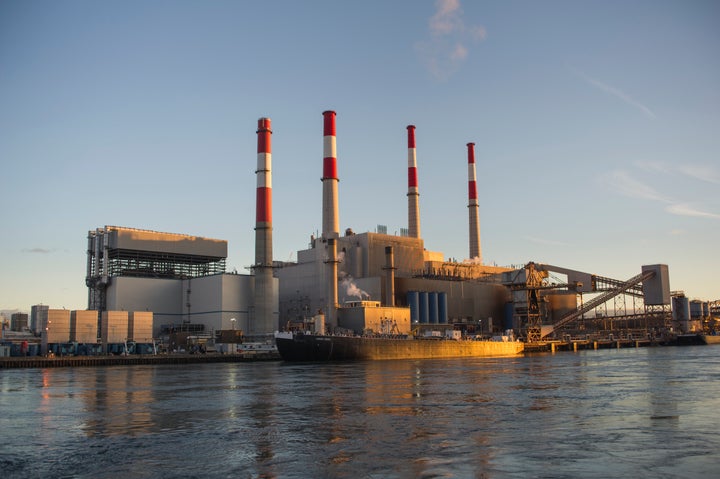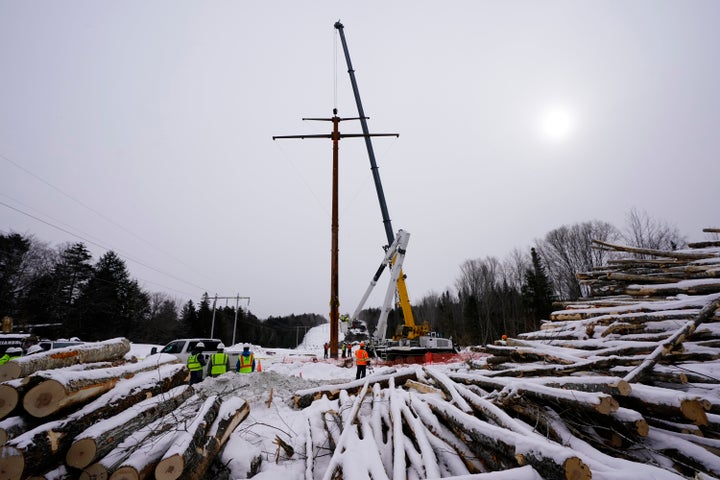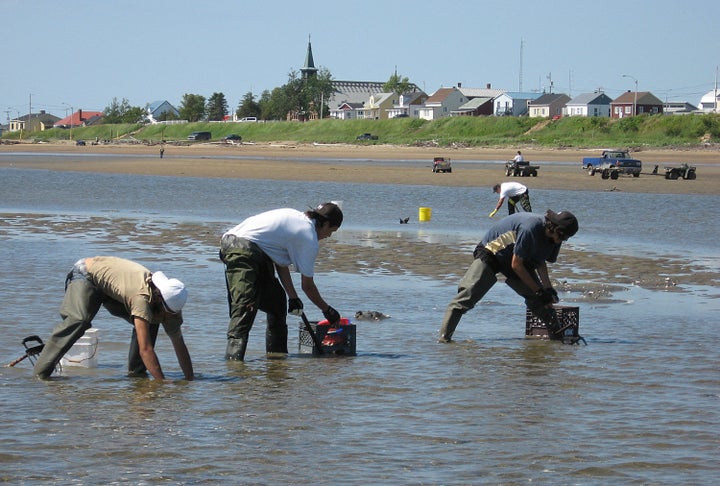Last April, New York City marked its 51st Earth Day by suing fossil fuel companies over climate change. A week later, the city started burning even more fossil fuel when its largest source of zero-carbon power, the Indian Point nuclear plant, shut down.
The move put New York in league with California, Germany and other places that purport to view global warming and the air pollution from burning oil and gas as urgent crises, but have simultaneously shuttered nuclear facilities, which generate massive amounts of power without carbon emissions.
With Indian Point closed, roughly 90% of the city’s grid is powered by fossil fuels. Now, New York faces yet another test of its legally mandated commitment to slash its planet-heating emissions by the end of the decade.
On Thursday, state regulators will decide the fate of a long-fought proposal to run a transmission line down the Hudson River from hydropower dams in Québec to the New York City neighborhood of Astoria.
The project, called the Champlain Hudson Power Express, would replace half of the capacity lost when Indian Point’s reactors stopped running and provide the kind of fast, reliable electricity that weather-dependent renewables like wind and solar struggle to produce on their own. Unlike other proposals that competed for state approval, the transmission line, known by its acronym CHPE and pronounced “chippy,” has all its state and federal permits and support from the mayor, governor and president. Public comments overwhelmingly favored building the project. And it’s ready to begin construction with union labor in a matter of weeks, with the potential to deliver power as early as 2025.
Yet as the state Public Service Commission weighs whether the lucrative contract to build and operate the project is in New Yorkers’ interest, a small but vocal alliance of gas companies, environmental groups and Indigenous tribes has formed to persuade regulators to kill the transmission line. Their reasons for opposing the project range from concerns over the costs to New York ratepayers and competition to New York energy companies, to fears that Hydro-Québec, the government-owned utility behind the project, might prioritize Canadians in a disaster or repeat its ugly history of seizing Indigenous lands in Canada to build more dams and increase its electricity output.
“This is an unethical project,” said John Lipscomb, vice president of Hudson Riverkeeper, an influential conservation group that previously supported the proposal. Referring to the hydropower as “blood energy” that would be “stolen” from First Nations tribes, he said, “We talk in New York about how we want to support traditionally marginalized communities, but we find a way to overlook these fatal flaws so we can check a green box.”
Instead, groups like Riverkeeper and Sierra Club, along with local gas-burning power generators, want the state to block the Champlain Hudson and kick off a new contest for alternative projects.

But such a move would likely delay the delivery of new, clean electricity sources until the end of the decade, and increase costs since the existing Champlain Hudson contracts locked in prices before the current inflation crisis began. On Tuesday night, New York Communities for Change, a progressive climate group, recanted its yearslong opposition to Champlain Hudson and called on the state to approve the line, noting that no other project has any hope of coming online as quickly.
“While we respect opponents making good faith arguments against this project, we believe there is simply no time left to waste to bring renewable energy to New York City,” the group said in a statement. “No transmission project is perfect. All have real and painful downsides. Nonetheless, we have decided to support CHPE because it will rapidly reduce New York City’s massive climate impact.”
For many who live in western Queens’ power plant corridor, nicknamed “Asthma Alley” over the lasting health effects of smokestack pollution, more time means more breathing problems.
“All those environmentalist groups that say we can wait? Let’s find out where they live at,” said Bishop Mitchell Taylor, a preacher and supporter of the project who grew up near the Queensbridge Houses, neighboring one of the city’s biggest and most visible fossil-fueled power plants. “They can wait because they don’t live in Asthma Alley.”
Why We Need A ‘Massive Buildout Of Transmission Lines’
The Champlain Hudson would run 339 miles south from Lake Champlain on the Canadian border and follow the water down along the Vermont state line before veering on land to avoid some sensitive aquatic ecosystems. Once it approaches the northern reaches of the Hudson River again, it would dive again back underwater until it reaches the city, at which point it would cut across Randall’s Island and arrive at a converter station in the vast electrical utility park in the northwesternmost corner of Astoria, Queens.
Roughly 40% of the line will be on land and nearly all of it will be buried, either underground or beneath river beds. The project will consist of two five-inch, bidirectional high voltage cables that will be able to transmit hydro and wind power down from Canada, and — if a contract is eventually negotiated to do so — send excess wind power from New York’s planned offshore wind farms back up north.
First proposed in 2008, the project — a joint venture between Hydro-Québec and Transmission Developers Inc., a company owned by private equity giant Blackstone Group — faced an uphill battle from the start.

Building new transmission lines is vital to shifting the U.S. electrical grid away from fossil fuels. Because renewables, which most analysts predict will be the cheapest way to generate electricity in the decades to come, depend on optimal meteorological conditions, a vast network of lines to carry power from where it’s produced to where it’s needed is key to ensuring that taking gas-fired plants offline will not cause blackouts. Eliminating emissions from vehicles and buildings means swapping internal combustion engines for batteries and gas stoves for induction heat. That could increase U.S. demand for electricity nearly 40% by 2050, according to a recent study by the National Renewable Energy Laboratory.
“Nobody likes their utility. Nobody likes transmission lines. The benefits of transmission lines are both quite real and very vague — broadly lower energy prices, broadly cleaner energy,” said Liza Reed, a climate policy expert at the Niskanen Center, a center-right think tank in Washington, D.C. “All of these are true but hard to see.”
Opponents of transmission projects have long held the upper hand in U.S. politics, thanks in part to arcane property rights rules that give landowners ample time and opportunities to challenge construction. Mired in regulatory red tape and political opposition, investors pulled the plug in 2009 on a project to build a 190-mile transmission line from upstate New York to the densely populated Hudson Valley. In 2015, a proposal to build a line from northwestern New York down to the city and its northern suburbs died when the village of Buchanen bought the land on which the developers would have built a substation and sold it instead to a gas company constructing a pipeline.
The problem is hardly unique to the Empire State. Journalist Russell Gold’s 2019 book “Superpower: One Man’s Quest to Transform American Energy” chronicled how local opponents and fossil fuel allies in Congress tanked a well-financed effort to construct a transmission line connecting wind turbines in gusty Oklahoma to cities in the southeast. More recently, Maine voters last November approved a referendum blocking construction of a separate Hydro-Québec line that would have carried hydroelectricity from Canada to New England’s gas-dependent grid.
The Biden administration, which backs Champlain Hudson and listed it among top priority projects, has taken some steps to make building transmission lines easier. The newly passed bipartisan infrastructure law directs billions to transmission issues and gives the federal government more power to designate a national interest in certain projects and routes to build them, making it easier for developers to overcome opponents.
“Fighting climate change means we want to electrify as much as possible, and if we don’t want to also build things like nuclear, we’re going to have to get it from zero-carbon resources that might be where the people are,” said Joshua Rhodes, an energy expert and research associate at the University of Texas at Austin. “Every single credible study that looks at how we get to a zero-carbon economy sees a massive buildout of transmission lines.”
Last November, just weeks after Maine’s vote, New York Gov. Kathy Hochul (D) announced finalized contracts with both Hydro-Québec and the developers of a second line, called Clean Path New York, meant to carry wind and solar power produced in New York 175 miles down from a substation in New York’s Delaware County to an electrical facility in western Queens.
Clean Path New York, which has yet to receive its permits, would come online at the earliest in 2027, two years after Champlain Hudson. But once completed, the two projects combined would slash the downstate grid’s emissions 51% by the end of this decade.
Connecting the northeastern U.S. to Québec’s grid follows a fairly straightforward logic. Look on any given day at the website Electricity Map, which provides real-time views of the carbon-intensity of various grids across the world, and you’ll see a completely green Québec neighboring a New York or New England in shades of yellow that, on some days, verge on orange. Luckily for fossil-fuel addicted Americans, Canadians already export a certain amount of clean electricity over the border. On Tuesday afternoon, the site’s data showed 1.53 gigawatts flowing from Québec into New England and 913 megawatts zapping into New York.

To accommodate more renewables, states such as New York, Massachusetts and Maine will need electricity that, like gas or coal, can run 24/7 regardless of weather and come online — or, in energy parlance, be “dispatched” — quickly if demand abruptly spikes.
Batteries may, at some point, prove cheap and efficient enough to provide those qualities at scale, but relying entirely on that technology raises questions about how much lithium, nickel and other metals can be mined to meet demand, especially when electric vehicles and cellphones are competing for those same minerals.
Technology like carbon capture and sequestration, which catches the CO2 and other pollution generated from burning fossil fuels before it enters the atmosphere, could allow the world to reach its climate goals without sacrificing existing power plants. But it’s so far extremely expensive, and requires, by one estimate, building nearly as many miles of new pipelines to carry captured CO2 as exist in the entire state of Florida.
Nuclear plants are by far the most efficient and reliable, and — despite popular misconceptions — among the safest forms of energy production yet harnessed by humans. But they’re also costly and deeply unpopular, particularly after the 2011 disaster at the Fukushima plant in Japan. All that makes hydropower more appealing, at least in places like the Northeast that are forecast to become wetter as the planet warms.
“Fossil fuel companies, they don’t fear wind. They don’t fear solar, because they still have a business case,” Sophie Brochu, the chief executive of Hydro-Québec, said in an hourlong sit-down interview with HuffPost at a community center in Astoria last November. “But with this system, which is reliable, clean, and competitive all the time, their business model is eroding.”
A Dark History With Canada’s First Nations
But hydropower has long been loathed by environmentalists. Building massive dams disrupts ecosystems and requires flooding large areas, which push out species and human communities alike. When forests are flooded, microbes in the soil can convert naturally occurring mercury into methylmercury, which then works its way through the local food chain. The effect, according to a 2016 Harvard University study, is to poison people that eat locally caught food like fish or seal meat. About 90% of proposed new hydroelectric dams in Canada threaten to increase Indigenous First Nations communities’ exposure to methylmercury, the paper concluded, though it is possible to mitigate the damage.
“Our research suggests that low impact hydroelectric projects are possible with careful site selection,” Elsie Sunderland, the study’s lead author, said in a press release. “Mitigation measures such as removing topsoil that provides the substrate for methylation in these ecosystems may need to be considered in areas where forecasted exposures are high.”

Hydro-Québec’s dams were built largely in the 1940s and 1950s on land seized from the Innu, Atikamekw and Anishinabek First Nations. The simmering conflict came to a head in the 1970s, when the Cree and Inuit peoples protested the construction of new dams and forced the Québec government to the bargaining table. The feud yielded the historic James Bay and Northern Québec Agreement, considered by some to be the first “modern treaty” between aboriginal peoples and the Canadian government.
Yet life on the Indigenous lands that surround Hydro-Québec’s dams remains difficult. Median income can be less than half the provincial average, and many still lack sewage systems, running water, and access to the electrical grid, forcing them to rely on noisy and polluting generators despite the neighboring hydro dams, the investigative site New York Focus reported last year.
As the company pushed to build its transmission projects in New York and New England, the chiefs of several of those tribes, in a letter co-signed by a handful of Native American tribes, urged the U.S. and Canadian governments to “intervene on our behalf” and force Hydro-Québec and Québec leaders to “sit down with us and negotiate.”
“Hydro-Québec claims to offer green energy to American consumers, while making billions of dollars in profits at the expense of the Indigenous peoples whose ancestral lands it exploits,” the letter read. “We are tired of this.”
In July, the Mohawk Council of Kahnawà:ke, a First Nations band with a population of nearly 11,000 registered members, made a deal with Hydro-Québec, becoming joint owners of a stretch of the Champlain Hudson transmission line in Canada. In a separate HuffPost interview last November, Kahsennenhawe Sky-Deer, the newly elected grand chief of the Mohawk Council of Kahnawà:ke, called the deal “unprecedented.” Noting that only a small minority of First Nations in the province challenged the project, she urged Indigenous opponents to set aside historic grievances and embrace industrial projects that promise to cut emissions.
“Looking at where our mother is right now, in the grand scheme of global warming, if we don’t start changing the way we’re doing things, we’re all in trouble,” she said. “So it’s not to be looked at now as a racial thing. All the stuff that’s happened in the past, the experience of marginalized people, indigenous people, Black people, Latino people, we have to put all of that behind us and collectively, collaboratively see what we can do differently.”
Days later, Hydro-Québec announced a new commitment to work more closely with Québec’s 11 First Nations, which total more than 107,000 people, including donating more money to education programs and hiring more from within the communities.
The contract the company negotiated with New York City also stipulates that Hydro-Québec cannot sell electricity from new dams built after the deal was signed. That would still qualify some projects under construction to produce hydroelectricity for New Yorkers, but it also created demand for Hydro-Québec to buy more wind energy to boost the power supply on the line. One of the wind farms is the Apuait, a 240-megawatt project co-owned by Québec Innu communities. Future renewable power lines will also require consulting tribes.
That did little to assuage concerns at Riverkeeper, which said those deals don’t offset the damage caused by new dams. It also raised concerns over how species in the Hudson would respond to the electricity, and what kinds of pollutants could be dredged up in the construction process. The group initially supported the Champlain Hudson, which it touted as a way to justify shutting down Indian Point. But after new board members took over the group — and after the nuclear plant closed — Riverkeeper changed its position.

“It’s one thing to have a cable running through your land that’s buried. It’s another thing to have dams and reservoirs on your land against your will that flood thousands of square miles of your traditional habitat,” Lipscomb said. “If we were to say to New Yorkers, we’re going to build equivalent sized dams in the Catskills or Adirondacks, there’d be one kind of response versus another response for one buried cable. It’s not comparable.”
Fossil Fuel Rivals Seek To Stoke Intrastate Rivalries
In Albany’s halls of power, a different story about why to oppose the Champlain Hudson is being told by industry players. For years, the Independent Power Producers of New York, a trade group for the state’s energy utilities, has argued that the transmission line will sap money from the city’s budget and drive up electricity prices upstate.
In a white paper, IPPNY said that Hydro-Québec would divert electricity away from lower-cost markets in upstate New York, where it has exported power for over a century, to high-paying customers in New York City, reducing the supply for the northern parts of the state and driving up costs. The state estimated that some upstate ratepayers could see as much as a 10% hike on bills.
“Nobody knows what that ratepayer impact is going to be on your bill,” IPPNY CEO Gavin Donohue said. “I don’t know, and I do this for a living.”
But Hydro-Québec’s said that double-digit rate increase was cherrypicked from a worse-case scenario state regulators modeled, and argued that analysis fails to consider how much higher rates would be with a delayed, inflation-afflicted alternative. Moreover, the project will be financed in large part through the state Renewable Energy Credit market, with the help of a clause slipped into New York City’s landmark 2019 law requiring big buildings to slash energy use or face fines. The legislation allowed landlords to purchase credits from the hydropower line. The combination of demand for credits and the relatively cheap cost of hydropower could, backers of the project hope, actually bring rates down.
And New York City is ready to welcome the project. Mayor Eric Adams, who supports the Hydro-Québec plan, has already budgeted $75 million in 2026 for the project, a spokeswoman said, but noted that the current price estimate may be adjusted over time. Between Champlain Hudson and Clean Path New York, the city expects to pay between $2 billion and $4 billion over the next 25 years — a large number, but still a tiny fraction of what the five boroughs spend on schools and police.
“The Champlain Hudson Power Express line and Clean Path New York are vital projects for our city and state. Not only will they help us meet our sustainability goals — they will also be a boon to our recovery, helping to create thousands of good-paying jobs for New Yorkers,” the mayor said in a statement. “Unlocking the potential of the green economy is one of my administration’s key priorities, and we look forward to advancing this project in partnership with local and state officials.”
“If we can’t say yes to a project like this, I worry about our ability to hit all of our goals, because we’ve got to be able to make choices like this that put us on the path to clean energy and away from fossil fuels.”
- Dan Zarrilli, former climate adviser to the New York City mayor
Still, upstate companies are frustrated that a converter station in New York that Hydro-Québec included in one of its alternative bids, which would have allowed renewable energy developers in the region to benefit from the transmission line, did not make it into the winning proposal. That wasn’t Hydro-Québec’s choice — state regulators turned down that proposal. But the talking point could still hold sway over the seven-member Public Service Commission, five of whom hail from the northern parts of New York. Only one represents New York City, and another is from Long Island.
“We have a lot of companies that I work for that want to do business in New York State, they want New York jobs, they want to pay New York taxes,” Donohue said. “Why aren’t we taking care of in-state resources, in-state jobs, and in-state power? Instead we’re going to Canada.”
A better project, he said, would be one that allowed for technologies that existing fossil fuel companies are more amenable to, including carbon capture and hydrogen fuel.
But Costa Constantinides, the former New York City Council member from Astoria who spearheaded the 2019 energy-efficiency law, said if the commissioners reject the project over costs, they ought to come explain that to his neighbors, many of whom are “families spending thousands of dollars on asthma medication.”
“If you vote no, you better damn well come down to Queens and give us an explanation,” he said. “Don’t you dare hide in Albany behind your bureaucracy. You’re reaffirming the commitment to fossil fuels in New York City if you vote against this project.”
The other argument against Champlain Hudson is that the proposed contract only mandates Hydro-Québec to sell the city power during the summer months, when the sweltering heat makes air conditioning necessary and drives up electricity demand. But the city banned gas hookups in new buildings, and Constantinides’ law incentivizes landlords to cut fossil fuel use. As a result, New York City’s electricity demand is set to surge as heat pumps and electric heaters switch on in the winter months from the 2030s onward, according to forecasts from the New York Independent System Operator, which oversees the state’s grids.
Opponents of Champlain Hudson say even if there is available electricity in those frigid months, it will likely go to Canadian customers, likely enduring even colder temperatures. But Hydro-Québec said it’s too early to tell what that market will look like, or when exactly the city’s demand will start peaking in the winter. But it suggested it would likely continue to sell capacity ― in which the company is paid to keep its generators ready through the winter in case of a surge in demand ― even if it wasn’t contractually obligated to do so, because it will make more money.
“This is a portfolio approach but somehow it’s being pitched as are you for hydro or are you for wind. The reality is, we need both,” said Dan Zarrilli, the former New York City mayor’s climate adviser who served in both the Bloomberg and de Blasio administrations. “The fact that this project is permitted and ready to go should make this a simple choice for all of us.”
He added: “If we can’t say yes to a project like this, I worry about our ability to hit all of our goals, because we’ve got to be able to make choices like this that put us on the path to clean energy and away from fossil fuels.”
Leaning back on a bench as a brisk autumn gust blew through the community center in Astoria last November, Brochu cautioned against seeing her company’s project as a panacea to New York’s energy problems.
“It’s not perfect, it’s not the only solution, it’s not a miracle, but it’s a real contribution to the hopes, dreams and aspirations of one of the largest metropoles in the world,” she said. “This is a beautiful flower. But it has to be in a beautiful bouquet.”


